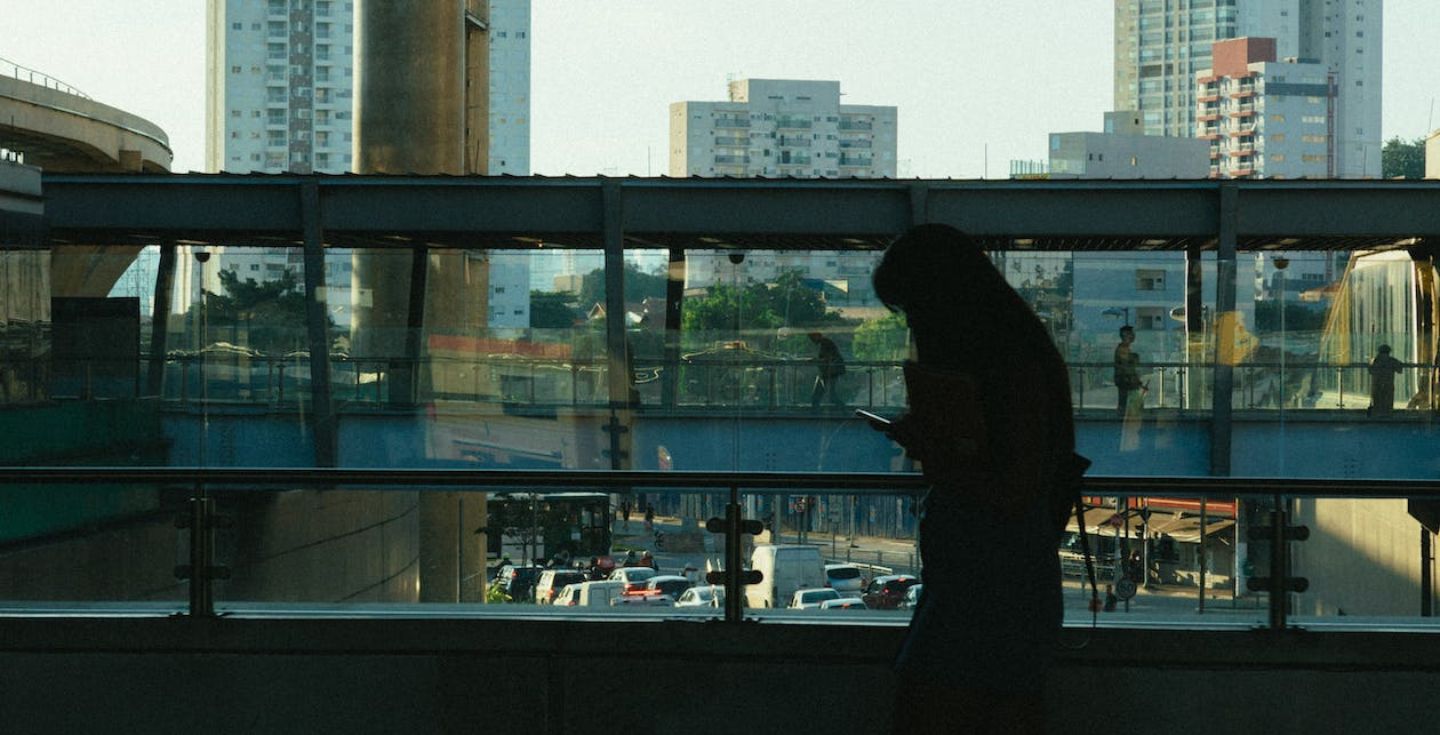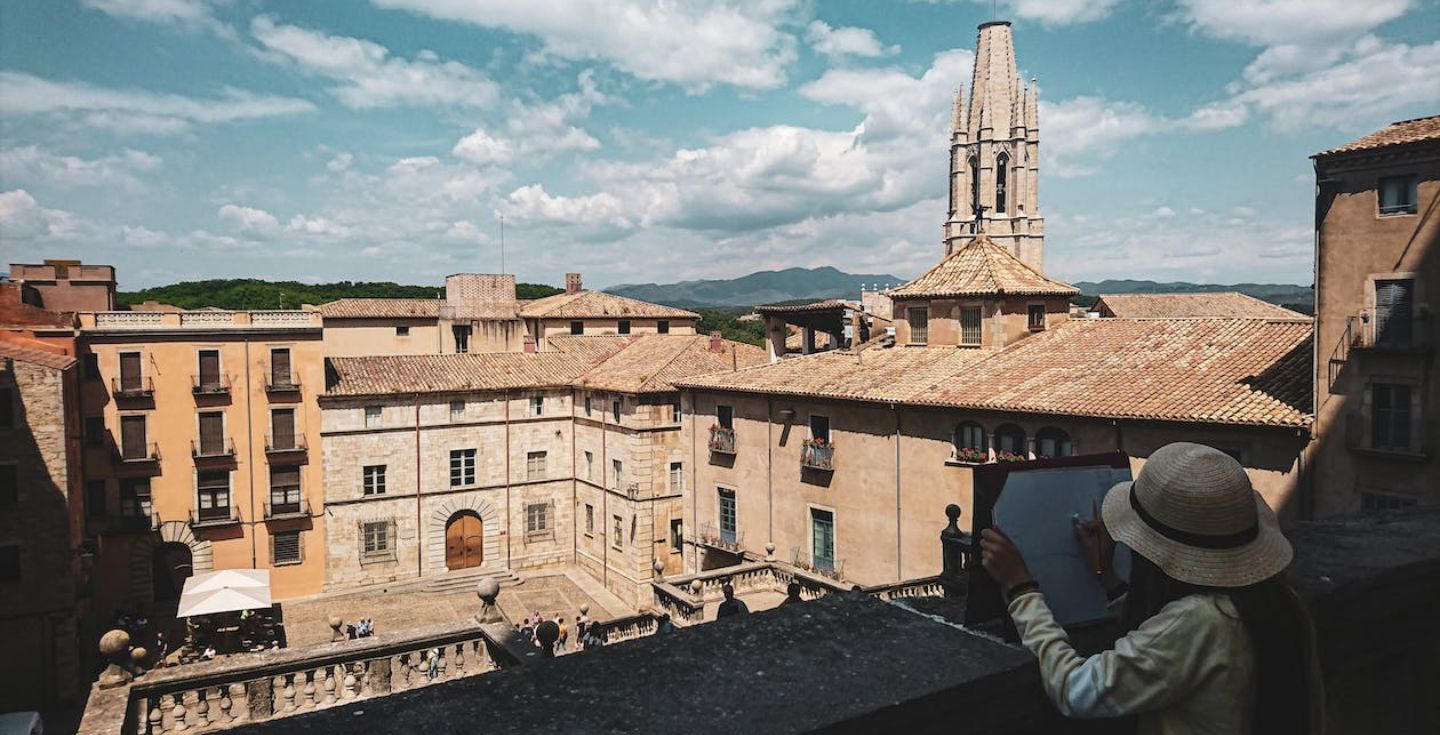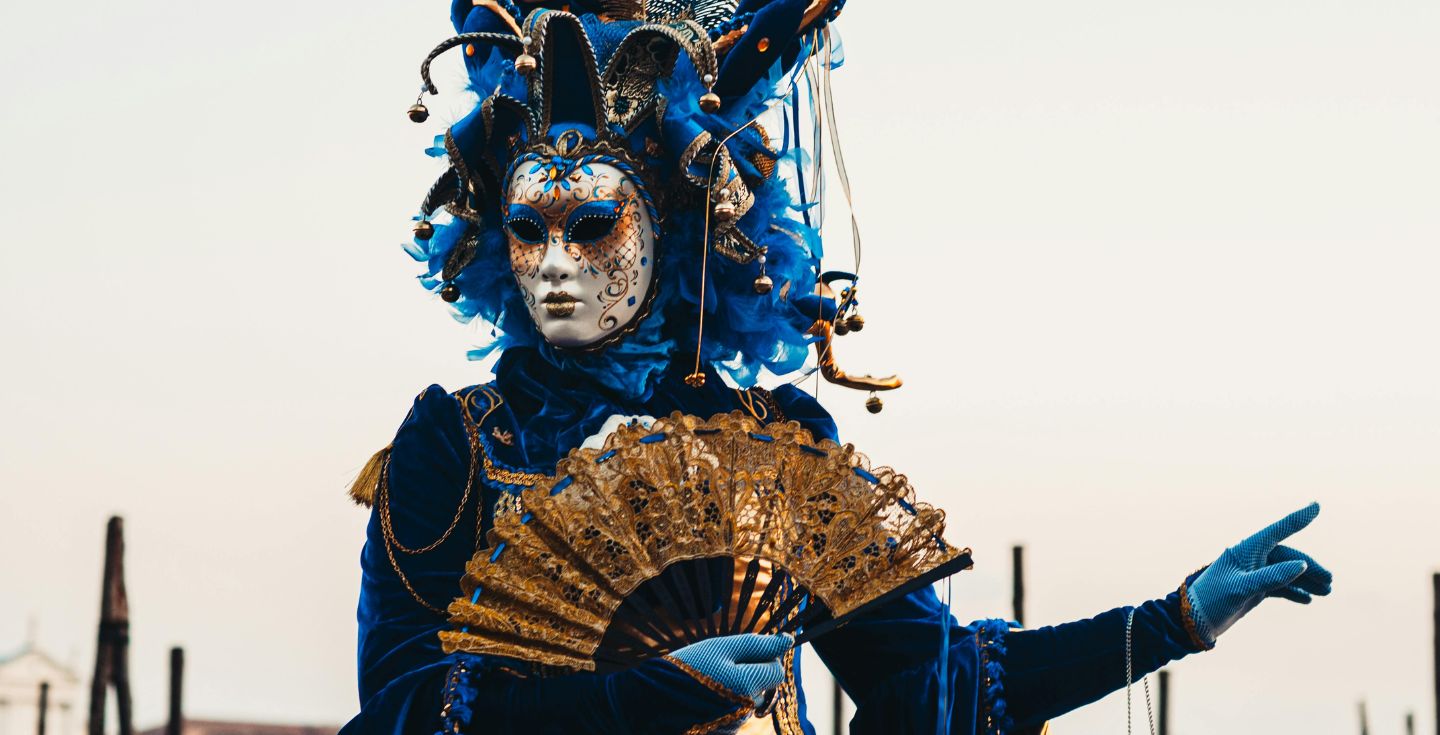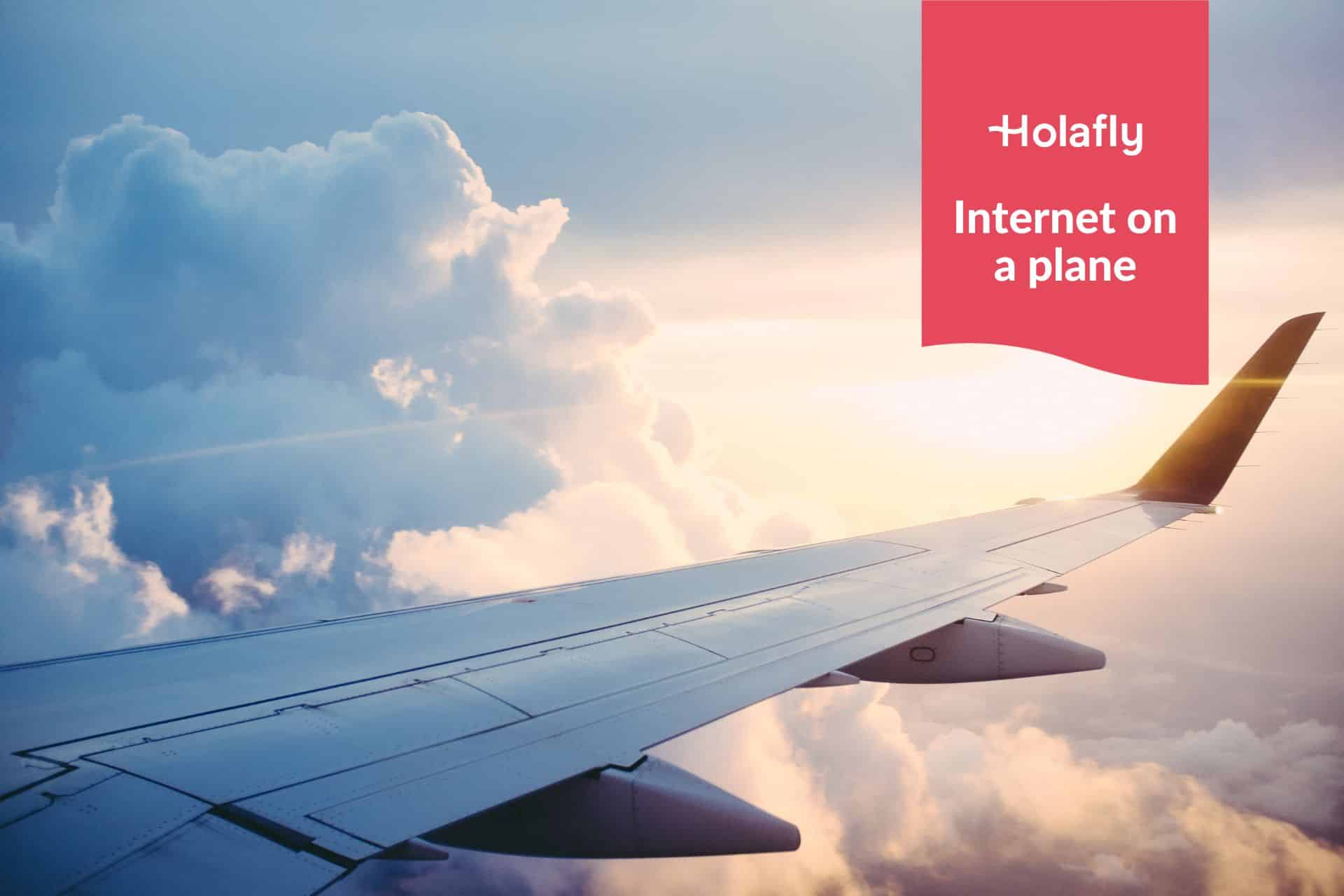The travel-ready Vietnam packing list
Packing for Vietnam? Here’s what you need to know to pack light for your trip and experience the best of Vietnam.
With its stunning landscapes, friendly locals, and incredible food, Vietnam has quickly become one of my favorite travel destinations in Southeast Asia. And the best part?
The visa process is quick and easy, which makes it perfect for a spontaneous getaway.
But how do you know what to bring to Vietnam? Here’s a detailed checklist of what to pack for Vietnam — perfect for any season or activity you have planned for your visit.
Download your packing list for Vietnam
Ready to start packing? Download this printable Vietnam travel packing list to make sure you don’t forget anything.
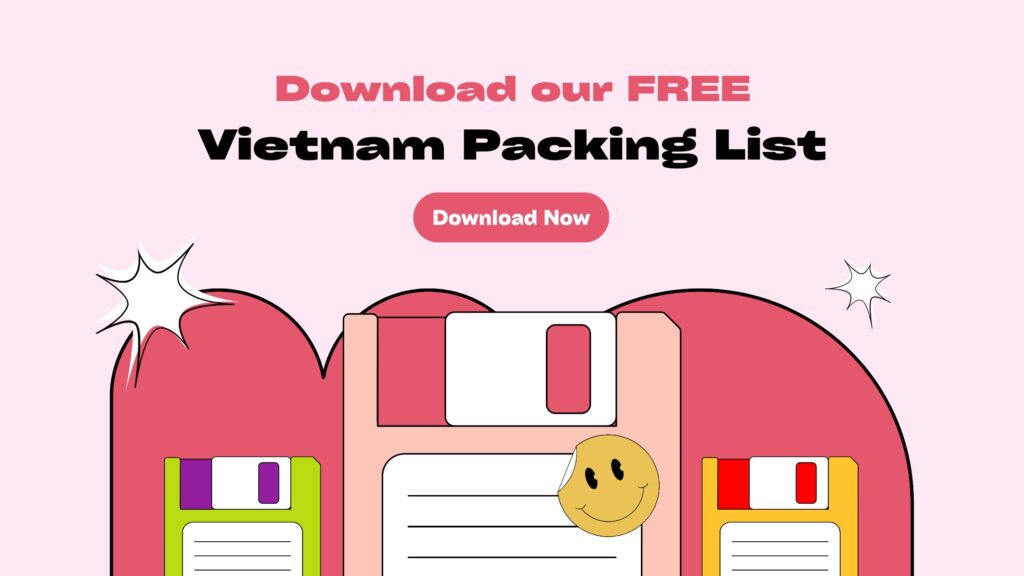
What to consider before packing for Vietnam
Before you get your suitcase out, let’s do some prep work. This will help you pack smart, save space (and baggage fees), and avoid lugging around unnecessary stuff.
Climate and weather conditions
Thanks to its monsoons and varied geography, Vietnam’s weather is as diverse as its landscape. Let’s quickly go over the different seasonal weather patterns affecting Vietnam, and how they’ll influence your packing decisions.
North Vietnam (Sapa, Hanoi, Halong Bay)
North Vietnam experiences all four seasons, with hot, humid summers and even the occasional snow during the winter months.
- Winter (November–February): It’s usually cold and dry, so pack some warm clothing — jackets, sweaters, and thermals.
- Spring (March–May): While the weather is mostly mild, you can expect occasional rain, so pack a light jacket, and don’t forget your umbrella.
- Summer (June–August): It’s hot, humid, and rainy. Pack lightweight clothing for sunny days, and a raincoat and waterproof shoes for the downpours.
- Autumn (September–October): The dry, warm fall weather is perfect for outdoor activities. Take your trekking shoes and sportswear.
Central Vietnam (Hoi An, Hue)
Unlike North Vietnam, Central Vietnam has just two main seasons, dictated by the monsoon season and winds.
- Dry season (February–August): It’s hot and humid, with occasional rain showers. Pack lightweight clothing, sunscreen, and an umbrella.
- Rainy season (September–January): You’ll experience frequent heavy rainfall and even occasional typhoons. Pack a raincoat, umbrella, and waterproof footwear.
South Vietnam (Ho Chi Min City, Mekong Delta)
South Vietnam’s climate patterns are pretty similar to Central Vietnam, with a dry season and a rainy season.
The difference is the timing: South Vietnam’s dry season is a bit later, stretching from December to May.
Luggage restrictions
Before you start packing, check with your airline about the weight limits and dimension requirements for both checked and carry-on luggage.
You’ll typically find this information under sections like Baggage Policy or Travel Information on airline websites.
While the common dimensions for luggage can vary depending on your airline, here are the commonly accepted ones:
- Carry-on: 22 x 14 x 9 inches (56 x 36 x 23 cm)
- Checked: 28 x 18 x 12 inches (71 x 46 x 30 cm)
Apart from your carry-on, you can usually bring a small bag to keep under the seat for things like laptops or books. But if your bag is too big, you might have to put it in the overhead bin — and sometimes, this can cost extra. So check with your airline beforehand.
If your trip is short and you can pack light, consider traveling with just a carry-on. That way, you can avoid checked bag fees and the hassle of waiting at baggage claim.
Clothing essentials for Vietnam
Vietnam has a lot to offer in terms of activities. The trick to packing smart is creating a capsule wardrobe so you can go from sightseeing to beach days to fine dining with a few creative swaps.
Think: a sundress that’s light and comfortable during the day but can be dressed up with some jewelry for a night out. Or chinos that can be paired with a t-shirt for casual outings or a button-down for a more formal occasion.
Clothing packing list for women
- Cotton or linen tees and tank tops
- Shorts, skirts, or lightweight pants
- 1–2 sundresses
- Long skirts/dresses for temple visits
- A lightweight jacket or sweater
- A couple of swimsuits
- A sarong that can be used as a shawl (for cold evenings), or cover-up (for temple visits)
- Yoga pants and athletic tees ( if you plan to go hiking)
- Accessories like hats, scarves, jewelry, and gloves
Clothing packing list for men
- T-shirts and button-down shirts in different colors and styles
- Lightweight, quick-drying pants like chinos or cargo pants
- A couple of jeans and shorts
- Thermal tops or long-sleeved moisture-wicking shirts
- Swim shorts or a bathing suit
- Lightweight or fleece jackets
- A rain jacket or poncho
- Accessories like belts, hats, and gloves
Clothing packing list for children
- T-shirts, tank tops, or sweatshirts
- Shorts and pants
- Dresses
- Raincoats
- Sweaters and jackets
- Thermal (or Merino wool) shirts and leggings for layering
- Pajamas
- An extra shawl (or sarong) that can double as a blanket
Clothing essentials by season
Let’s dive deeper into specific clothing suggestions based on the season and your planned activities.
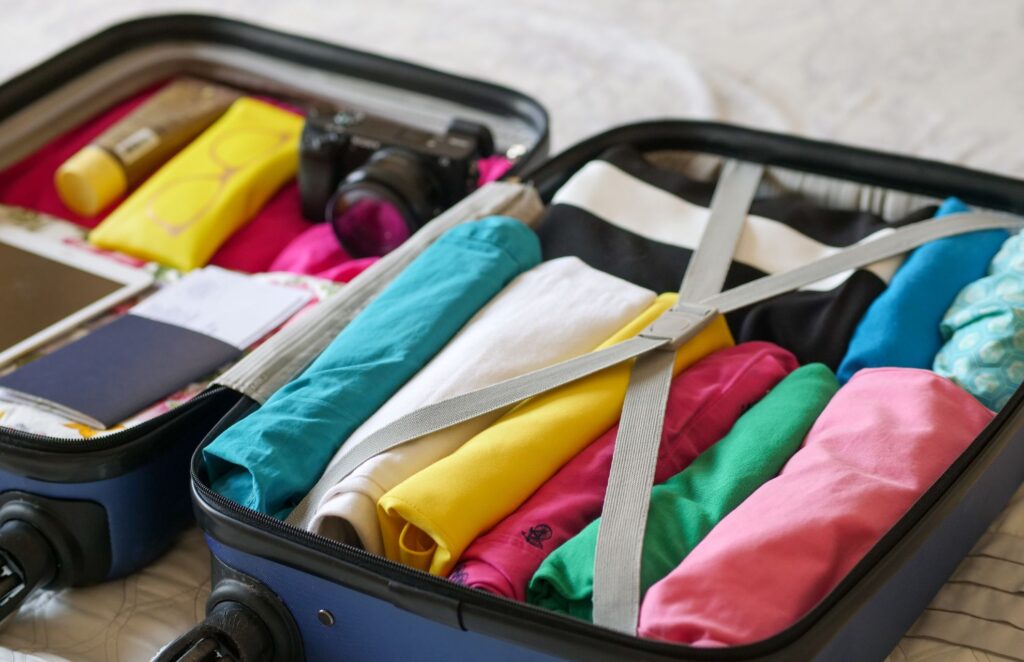
Winter clothes
- For men: Warm sweater or fleece jacket, long-sleeved shirts, winter boots, sports coat
- For women: Jeans, long skirts and dresses, full-sleeve tops, cardigans, thermal leggings
Dry season clothes
- For men: Cotton or linen shirts, lightweight pants, shorts, flip-flops
- For women: Flowy maxi dresses, shorts, skirts, and breathable tops
Rainy season clothes
- For everyone: Raincoats, quick-drying pants, umbrellas, waterproof shoes
Footwear
When it comes to footwear, it all depends on what activities you’ve planned. Here are some basic guidelines:
- Beach: Opt for flip-flops. They’re waterproof and lightweight
- Sightseeing: Sneakers (if it’s cold) and sandals (for warm weather)
- Dinner out: Dress shoes, loafers, heels, or sandals
- Trekking: Athletic shoes with ankle support
Must-have items for your trip to Vietnam
Now for the most important part — the non-negotiables you can’t do without on your Vietnam trip.
From travel documents to clothes and electronics, here’s everything you need to start your trip on the right foot.
Essential documents
Let’s start with the boring but important stuff first — your paperwork. But the good news is it’ll only take you an hour or two, maximum, to get this done.
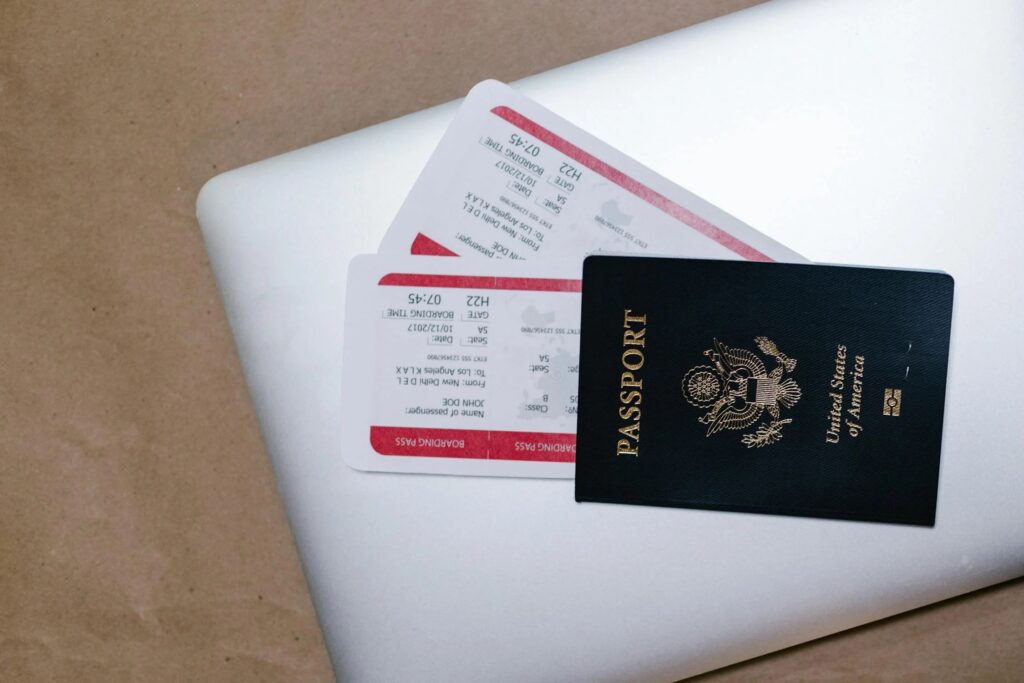
Passport and visa
The first document on this list is your passport. Make sure your passport is:
- Valid for at least six months beyond your initial departure date
- You have at least two blank pages for the visa stamp
For most nationalities, you can obtain a visa on arrival or apply for an e-visa. If it’s the second, ensure you apply at least two weeks in advance to allow sufficient processing time.
And here’s what you’d typically need for a visa on arrival:
- Passport
- Passport-size photos (2)
- Vietnam entry application form (Form NA2)
- Visa approval letter from a tour operator
- Stamping fee ($25 for single entry; $50 for multiple entry)
However, visa policies can change, so check the specific visa requirements for your nationality on the official website of the Vietnamese Immigration Department at least a month before your travel date.
Travel insurance
While travel insurance is not mandated for travel to Vietnam, we recommend you purchase it. Travel insurance can protect you from unexpected medical emergencies, trip cancellations, lost luggage, theft, and even evacuation costs, so you can travel without any worries.
It’s generally advised to have a travel insurance policy with a minimum coverage of $50,000. If you have pre-existing medical conditions, are traveling with children, or are staying for an extended period (three months or more), you might want to consider a higher coverage plan.
Vaccinations
The CDC (Center for Disease Control and Prevention) advises all international visitors to Vietnam to take certain vaccinations to avoid unnecessary stress. These include:
- COVID-19
- Chikungunya
- Hepatitis A and B
- Malaria
- Measles
- Rabies
- Typhoid
Consult with a healthcare provider to determine the appropriate vaccinations for you. Also, it’s recommended that you get your vaccinations at least six to eight weeks before your travel date, so plan ahead.
Once you’ve got your vaccinations, make sure to keep both electronic and physical copies of your vaccination records. You might need to show them at immigration or to a doctor in Vietnam.
Credit/debit cards and cash
While major credit and debit cards are widely accepted in larger cities and tourist areas, most locals prefer cash. So carry a mix of both.
For cards, enable international transactions and check with your bank if your card is compatible with Vietnamese ATMs.
When it comes to cash, the Vietnamese Dong (VND) is the official currency. You can exchange currency at banks, exchange bureaus, and airports.
Carry small denomination notes as they’re more convenient for street shopping and paying local vendors.
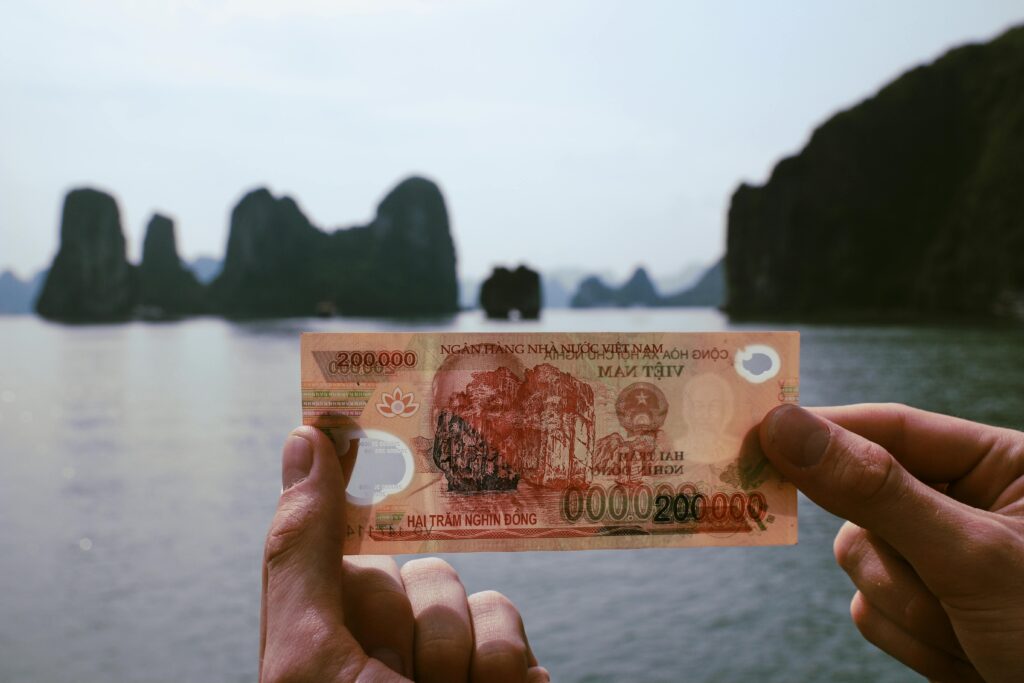
Photocopies of important documents
While you can show an electronic copy of your flight tickets, hotel rooms, and such during boarding and immigration, having physical copies can help you stay organized — especially if you’re traveling with family and have a lot of documents.
You’re also likely to find pickpockets in most big cities such as Ho Chi Minh, Hanoi, and Nha Trang — particularly in crowded areas.
Keep your valuables and original documents in your hotel safe and only carry photocopies of important documents with you.
Toiletries and personal care items
While you can find basic toiletries in Vietnam, it’s easier to bring your own. That way, you have your favorite brands and don’t have to worry about finding them.
Toiletries
- Toothbrush and toothpaste
- Floss and mouthwash
- Travel-size body wash
- Travel-size shampoo and conditioner
- Hairbrush or comb
- Shaving kit (for men)
- Deodorant or antiperspirant
- Moisturizer
- Sunscreen with at least SPF 50
- Wet wipes
- Tweezers
- Nail clippers
- Insect repellent
Personal care items
- Feminine hygiene products
- Contact lens solution and case
- Hand sanitizer
- Blowdryer or hair straightener
- Dry shampoo (Vietnam can get humid and sweaty)
- Lip balm
- Makeup and makeup remover
Medications
- Prescription medicine (insulin, blood pressure, and such)
- Inhalers
- EpiPens
- Over-the-counter medicine
- Antacids
- Diarrhea medicine (loperamide, bismuth subsalicylate)
- Altitude or motion sickness pills
- Saline nose spray
- Mild laxatives
- Fever or pain medicine (aspirin, ibuprofen, acetaminophen)
You can also carry a basic first-aid kit with bandaids, antifungal ointments, and antiseptic cleaners — especially if you plan to get adventurous.
Extra: If you’ve got a long flight (10 hours or more), take a neck pillow, eye mask, and earplugs for a comfortable trip. A light jacket or shawl can also help.
Electronics and staying connected
The final category on your packing checklist is tech essentials — so you can stay connected (and entertained) on your trip.
Gadgets
- Smartphone
- Powerbank
- Smartwatch
- E-reader
- Headphones
- Camera
Cables
- Phone charger
- Universal power adapter (Vietnam uses Type A, C, and F plugs)
- USB cable
- Camera charger and memory cards
- Selfie stick (if you plan on doing vlogs)
Local SIM or eSIM
You’re going to need mobile internet in Vietnam for pretty much everything — from booking your rides to checking out restaurant ratings. But international roaming can get super expensive.
To stay connected, you can buy a local Vietnam SIM card on landing. You’ll find tourist SIM card counters at most international airports. You can also consider renting out a pocket WiFi for Vietnam if you need to share data to multiple devices.
These also give you decent network coverage. Popular SIM card providers in Vietnam are Viettel, MobiFone, and VinaPhone.
However, if your phone is compatible with eSIMs (embeddable SIMs), we suggest going that route to save on costs and give yourself peace of mind.
eSIMs are easier to purchase and activate than physical cards, and they offer a wide range of affordable plans.
Holafly, for example, provides unlimited data and zero roaming bills for VOIP calls. For a 14-day trip, a Holafly eSIM for Vietnam costs just $47.90, averaging only $3.42 per day.
You can easily set up your eSIM in under five minutes: simply scan the QR code in your purchase confirmation email after you land in Vietnam, and you’re good to go.
Packing list for activities in Vietnam
Have you ever paid three times the price for a last-minute beach towel? Or maybe you got blisters from breaking in your new hiking boots.
While these can seem like minor inconveniences, they can consistently (and negatively) affect your entire trip.
Here’s a breakdown of what to pack for your specific activities.
Outdoor adventures
Let’s start with some of the basics before we get into the activity-specific ones:
- Lightweight clothing that’s easy to layer
- Broken-in, sturdy footwear
- Backpack with comfortable straps
Also, tap water in most regions of Vietnam is unsafe to drink. So carry water purification tablets or a portable water purifier if you’re camping or traveling remote places.
Caving
Did you know Vietnam is one of the world’s top caving destinations? It’s home to some of the world’s most spectacular cave systems, including the world’s largest cave, Son Doong Cave in Phong Nha-Ke Bang National Park. If caving is on your itinerary, here’s what you should pack:
- Quick-drying inner clothes — try Merino wool or synthetic fibers
- Durable outer layers —they’ll get pretty dirty by the end of your trip
- Caving shoes or old hiking shoes that don’t have hooks for laces
- Headlamp or flashlight (with extra batteries)
- Trash bag — to take home your muddy outer layers
Hiking
As we’ve already seen, Vietnam’s weather is quite unpredictable. So check your weather forecast before packing to determine how many layers of clothing you’ll need for your hiking adventures.
Here are some general items to consider:
- Moisture-wicking base layers
- Waterproof outer layers
- Hiking socks and boots
- Backpack
- Water bottle
- Rehydration salts
- Sunscreen
- Insect repellant
- First-aid kit
- Pocket knife
- Flashlight
- A compass (in case your GPS doesn’t work)
- Sealable trash bag (or Ziploc) to pack your trash
Canyoning
If you’re planning to visit Sapa or Dalat and have an adventurous soul, then you should definitely try canyoning.
The only essentials are a swimsuit, lycra bottomwear, and grippy footwear — your hiking shoes should do. Your guide will provide all other equipment including the neoprene suit, helmet, and harness.
Kayaking
If Halong Bay or Lan Ha Bay are on your list of places to visit, we recommend kayaking. You get to see the iconic limestone karsts and colorful marine creatures. And if you’re lucky, you might even stumble across hidden lagoons and sea caves.
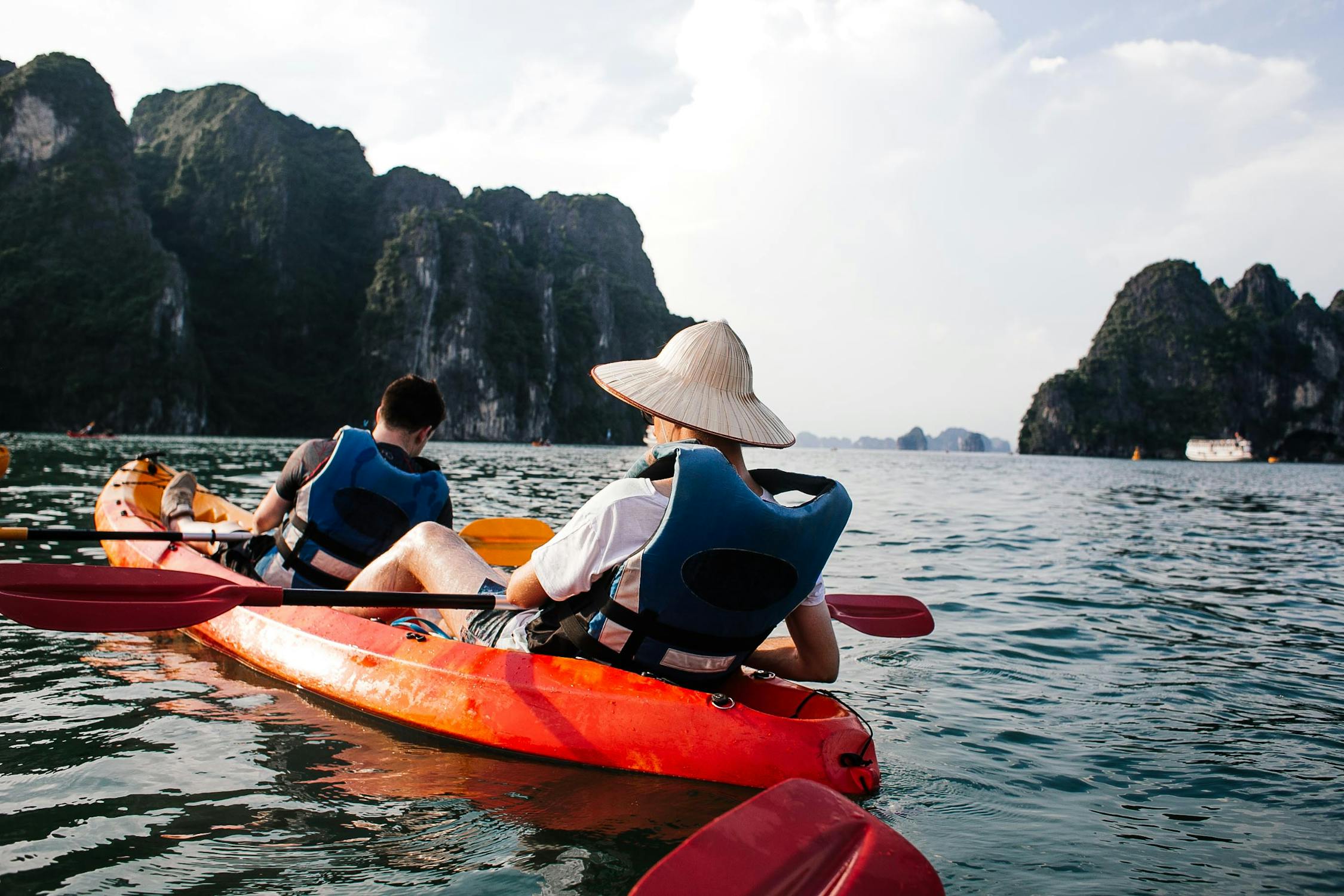
The key to packing for your kayaking trip is to consider water temperature, not air temperature. For warm waters (>60°F), go for regular swimwear or shorts. If the water is colder, pack a dry or wet suit, rain jacket, and some long-sleeved tops.
Other kayaking gear to pack:
- Kayaking gloves or Velcro pogies
- Waterproof container or bag
- Sunscreen
- Neoprene footwear
Finally, avoid cotton clothes (they take forever to dry) and clothes with zips (they can rust).
City and cultural visits
While Vietnam’s coastal areas have a relaxed dress code, the overall dress code is quite modest. In the city, casual clothing such as jeans, tees, shorts, and mid-length dresses are all good options.
If you’re visiting one of Vietnam’s many temples and pagodas, you must dress modestly, covering both your shoulders and knees.
Here’s where multi-purpose clothing like sarongs and shawls can help. Simply wrap a shawl around your shoulders or tie a sarong around your waist, and you’re set to go.
If you visit Vietnam in late January or early February, you might be lucky enough to catch the Tet Festival (Vietnamese Lunar New Year) celebrations.
Locals usually wear new clothes (in red) during this time to invite good fortune, so consider packing something fresh to join in.
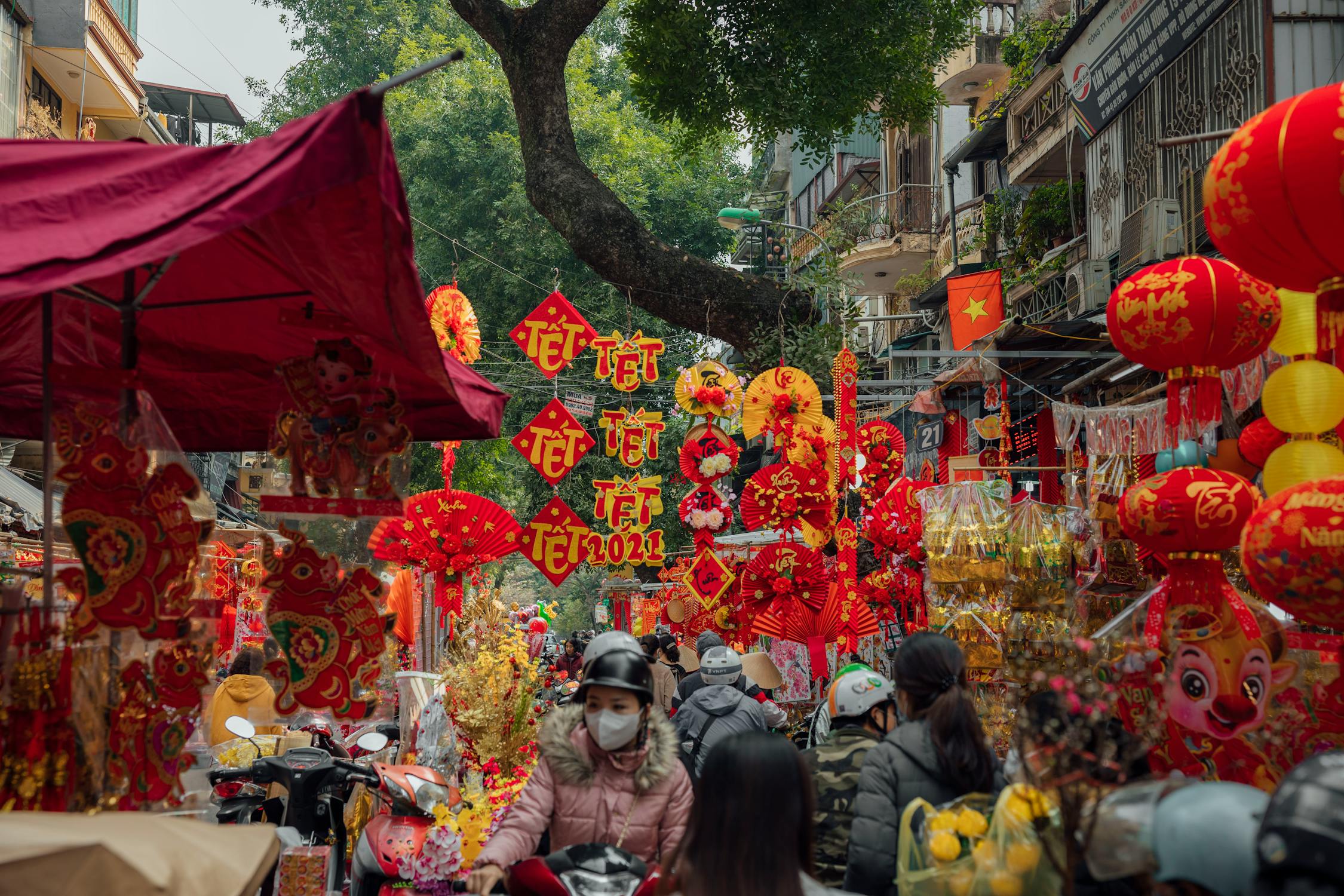
Dining and evening events
Vietnam’s culinary scene is exploding. Seven hotels in the country earned Michelin stars in recent years.
So if you have a date night planned or want to eat at one of the many gourmet restaurants, you need to pack some formals.
If you’re eating at an upscale restaurant, think collared shirts and dress pants (for men) or dresses (for women). For footwear, you can’t go wrong with dress shoes and heels.
And when it comes to casual dining and nightclubs, a smart casual dress code would work in most places. And, of course, some comfortable dancing shoes.
If you’re going on a cruise, the dress code is mostly relaxed. However, check the specific dress code guidelines provided by your cruise line.
What not to bring to Vietnam
Before we wrap up, let’s talk about what not to pack for your Vietnam trip — so you can save some space and avoid unnecessary (legal) hassle.
Prohibited or restricted items
Like most countries, Vietnam restricts illegal drugs, explosives, and weapons. It’s also good to avoid large quantities of any medication, even prescription drugs. Vietnam has recently banned e-cigarettes and vapes, so leave those behind as well.
Finally, avoid carrying anti-government propaganda materials, and if you’re carrying a physical map, go for one that labels the sea near Vietnam as ‘Eastern Sea’, and not ‘South China Sea’.
Unnecessary items
Pack depending on the duration of your stay. If you’re staying for a couple of weeks, bring your toiletries, feminine products, and sunscreen.
Anything longer, and you’re better off buying these things locally — unless you really like a specific brand. Other items you can skip are irons, kettles, and hair dryers — most hotels provide these.
Finally, don’t bring your tuxedos, suits, and gowns. Instead, get a custom suit or dress stitched by one of Vietnam’s talented local tailors.
They can replicate your dream outfits in a couple of days and at a fraction of the cost. You can find great tailoring shops in most cities, including Hoi An, Hanoi, and Ho Chi Minh.
Wrapping up your Vietnam packing list
Packing doesn’t have to be stressful. All you need is a little planning and the perfect suitcase. Start with our printable checklist and add in any specific items you may need. And with a country as diverse as Vietnam, be sure to consider both the climate and your itinerary.
Finally, double (and triple) check so you don’t miss any important documents. And don’t forget to get the best eSIM for Vietnam in advance so you can connect to the internet as soon as you land.





 Language
Language 


















 No results found
No results found






